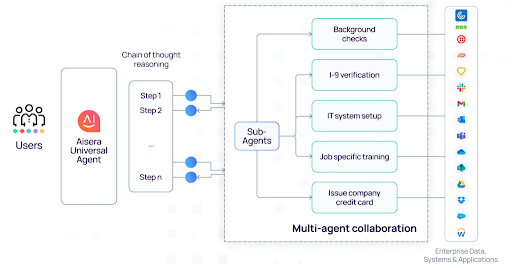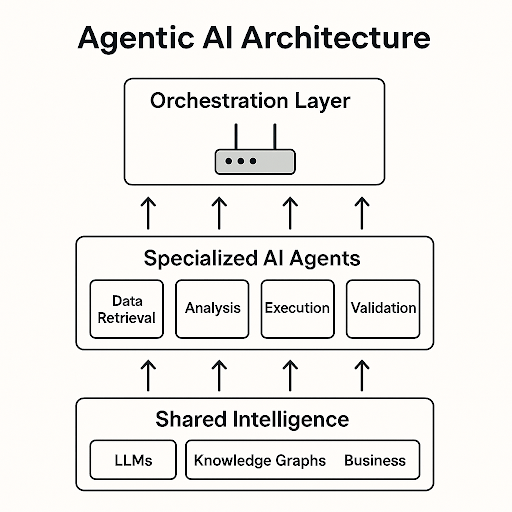Agentic AI Explained: Benefits, Use Cases & Implementation Strategies

Your AI chatbot can write emails. Your analytics tool can predict trends. But what if your AI could actually do the work? What if it could book meetings, process refunds, fix bugs, negotiate contracts?
That's agentic AI - and it's already happening!
Dow Chemical processes over 100,000 shipping invoices every year. Their new AI agent spots billing errors automatically and saves them millions in hidden logistics costs. Fujitsu's sales teams got 67% more productive after deploying an AI agent that builds proposals and manages client knowledge.
These aren't pilot projects or PR stunts. In fact, the agentic AI market is expected to grow from $7.84 billion in 2025 to $52.62 billion by the year 2030.
Here's why smart executives are paying attention towards this shift - Traditional AI waits for instructions. Agentic AI sets its own goals, makes decisions, and takes action. It's the difference between having a very smart calculator and having a very capable employee.
We’ll show you what agentic AI actually does, which use cases deliver the biggest returns, and how to implement it without impacting your existing operations.
What Is Agentic AI?
Think of your best employee. They understand your goals, spot problems timely, and handle complex tasks from start to finish without constant supervision.
That's agentic AI - except it works 24/7.
Agentic AI is an artificial intelligence system that can accomplish specific goals with limited supervision, using AI agents that mimic human decision-making to solve problems in real time.
The main difference is that these systems take action without waiting for your next instruction.
To pull this off, most modern setups rely on large language models (LLMs) for raw computational power and natural language processing (NLP) for nuanced understanding. That combo lets an agent process messy human requests, nail the intent, and map its own next move without any babysitting.
Agentic AI vs AI Agents Vs Autonomous Systems: What’s The Difference?
While the terms often get used interchangeably, there's a clear difference between agentic AI and AI agents
Agentic AI is the broader capability. It refers to AI systems that can pursue goals, make decisions, and take actions with minimal supervision. These systems often operate as utility-based agents evaluating possible actions by estimating which yields the highest benefit or utility based on defined goals.
AI Agents are the individual units within this system. Each agent is trained to solve specific tasks, like qualifying leads, processing invoices, or handling support queries.
Autonomous Systems is a more general term that includes any technology capable of independent operation, from self-driving cars to smart grid controllers.
Agentic AI is a specific type of autonomous system, designed to work like a high-performing employee within your business operations.
How Does Agentic AI Work?
Traditional AI stops at analysis. Agentic AI goes further as it also executes.

The process follows four stages: Perceive, Reason, Act, and Learn. These four stages closely resemble traditional production systems in AI, where rules and logic drive decision-making, but with a more dynamic, data-driven backbone. Beneath those stages, an LLM-powered reasoning core translates every data blip into plain-English objectives, while the NLP layer keeps every agent on the same page.
Learn how Agent AI Memory enables agents to retain context, learn from past actions, and evolve their strategies over time.
Here's what that looks like in practice:
Take Eneco[1], Belgium's energy provider serving 1.5 million customers. Their AI agents go beyond just monitoring energy demand. They automatically adjust distribution, predict outages, and rebalance the grid in real time.
When demand increases in one area, the system perceives the change, reasons through the best response, acts by redirecting energy flow, and learns from the outcome to handle similar situations better next time.

This continuous cycle forms the foundation of agentic AI workflows, where systems adapt to business patterns, seasonal changes, and unexpected situations without needing new programming.
Agentic AI Architecture
Agentic AI architecture runs on a simple layered model:
1. Orchestration layer: Routes every task, resolves conflicts, tracks outcomes.
2. Specialised AI agents: Each agent owns one function - data retrieval, analysis, execution, or validation.
3. Shared intelligence: Large language models (LLMs), knowledge graphs, and business rules that every agent can tap.

While generative AI creates content or data, agentic AI is focused on accomplishing tasks end-to-end. Understanding this difference is key when evaluating AI use cases in your business.
Quick heads-up: teams often kick-start pilots with open-source projects like AutoGPT or wire up Agentic Process Automation (APA) flows before hardening them for production. Start small, then scale once the business case proves itself.
In more advanced setups, businesses are integrating agentic RAG (Retrieval-Augmented Generation) pipelines into their knowledge layer. This allows agents to pull from internal databases or documents in real-time, improving accuracy and grounding decisions in proprietary data.
Why does this change everything?
Agentic AI can independently manage and complete tasks, communicating and collaborating with other AI systems on behalf of human users. Instead of replacing one manual step, it automates entire workflows. See how Agentic Reasoning enables proactive planning, decision-making, and adaptability across autonomous systems.
You're getting a digital workforce that operates whilst you sleep, handles exceptions without escalation, and improves its performance over time.
Companies struggle with the complexity and cost of operations. Agentic AI streamlines this by making decisions and getting work done automatically. Your team moves from task execution to strategic oversight.
Learn more about how agentic AI is being used to tackle real-world business challenges to solve business problems.
Agentic AI Vs Generative AI: Quick Comparison
Many executives confuse agentic AI & generative AI tools like ChatGPT. Here's the key difference in a nutshell:
| Aspect | Generative AI | Agentic AI |
|---|---|---|
| Primary function | Creates content (text, images, code) | Completes tasks and workflows |
| Autonomy level | Responds to prompts | Acts independently toward goals |
| Decision making | Limited to content generation | Makes operational decisions |
| Integration | Standalone tool | Connects across multiple systems |
| Business impact | Productivity enhancement | Process transformation |
| Learning | Static knowledge | Continuous improvement from actions |
While generative AI is accessible through user-facing apps, Agentic AI tools are designed to integrate deeply within enterprise systems connecting CRMs, ERPs, ticketing platforms, and custom APIs for autonomous execution.
Why Every Enterprise Is Racing Towards Autonomous AI In 2025
The enterprise world is facing a perfect storm of challenges that traditional solutions can't solve. Labour shortages, rising operational costs, and increasing customer expectations are forcing companies to rethink how work gets done.
These self-governing AI systems offer a way out of the following headaches for leaders:
-
Skills shortage and rising talent costs: Nearly half (47%) of executives[2] believe rethinking talent strategies in light of increased AI use will deliver better ROI. Customer service centres can't hire enough agents, finance teams are drowning in manual processes, and IT departments are overwhelmed by routine requests.
-
Strategic workforce redesign: Agentic AI handles routine work that's difficult to staff whilst freeing existing employees to focus on tasks requiring human expertise. Companies are redesigning work around what humans and AI each do best.
-
Machine-speed advantage: At CES 2025, Nvidia CEO Jensen Huang declared[3] that AI agents represent a multi-trillion dollar opportunity for businesses. Companies operating at machine speed will dominate those constrained by human-paced processes.
-
Market response velocity: When your competitor can process customer requests in minutes whilst you take hours, the market decides quickly. Speed becomes the primary differentiator in customer acquisition and retention.
-
ROI accountability era: The experimental phase of AI investment is over. Boards want measurable returns, and operational AI delivers the kind of efficiency gains that show up in quarterly results. AI governance focused on economic value leads to sustainable adoption.
-
Improving asset value: The economics are compelling because agentic systems improve over time rather than requiring constant reinvestment. Unlike traditional automation needing updates and maintenance, AI agents become more valuable as they learn business patterns.
Proven Business Benefits Of Agentic AI: Real ROI Data From Early Adopters
Early adopters of this proactive AI workforce are reporting returns that go far beyond typical technology investments. The data shows consistent patterns across industries and company sizes that will help your business make an informed decision.
Impressive, right? Here’s the four-phase roadmap to put autonomous AI on your turf.
1. Operational efficiency breakthroughs
26% of enterprises[4] are primarily looking for ROI through increased operational efficiency. This is where AI agents streamline operations, reduce manual work, and increase throughput. But the actual results exceed expectations.
-
Companies are seeing 3-5x improvements in process completion times for complex workflows.
-
Tasks that previously required multiple handoffs between departments now happen automatically. The compound effect eliminates bottlenecks that have constrained growth for years. See how Agentic AI in retail is driving similar end-to-end automation from intelligent shelf planning to dynamic promotions and real-time inventory response.
-
More importantly, these efficiency gains scale without additional investment. Once an agentic system learns a process, it can handle 10x or 100x more volume without proportional cost increases.
2. Customer experience and revenue impact
Ready-to-deploy agents address common business needs such as customer service, sales automation, and data analysis, providing a straightforward path to AI adoption.
-
The revenue impact comes from both improved customer satisfaction and increased sales capacity.
-
With agentic AI, customer resolution times drop from hours to minutes. This improved experience translates directly to higher retention rates and increased customer lifetime value.
-
Sales teams report being able to handle 40-60% more qualified leads because AI agents manage the initial qualification and nurturing processes.
3. Cost structure transformation
The financial benefits extend beyond simple labour savings. Agentic AI offers significant benefits by reducing human error, taking away the cost associated with inefficiencies, oversights, and mistakes.
Additionally, agentic systems reduce the need for expensive integrations between disparate software systems. Instead of building custom connections, AI agents can work across multiple platforms, acting as intelligent middleware that coordinates complex workflows. This kind of intelligent AI integration enables agents to act across CRMs, ERPs, and legacy tools without needing extensive dev cycles.
Did you know: What does ‘intelligent middleware’ mean here?
It’s the layer that connects your existing tools and platforms, helping AI agents talk to each system without custom integration work. This allows agents to complete workflows across apps like CRMs, ERPs, and ticketing systems seamlessly.
4. Scalability without complexity
One of marketing's biggest bottlenecks is scaling efforts without increasing headcount.
-
Whether serving 1,000 customers or 1 million, agentic systems maintain consistent performance without additional infrastructure investment.
-
This scalability advantage becomes critical during growth phases. Companies can expand operations, enter new markets, or launch new products without the traditional constraints of hiring and training new staff.
-
More data makes them smarter, more interactions teach them edge cases, and more complexity helps them develop sophisticated problem-solving capabilities.
How To Implement Agentic AI: Step-By-Step Guide For Enterprises
Most agentic AI implementations fail not because of technology limitations, but because companies rush into deployment without proper foundation work. Quite a lot of organisations aren't agent-ready.
Agentic AI isn’t just automation - it’s operational intelligence at scale. Here’s how to build AI agents for your business today.
Phase 1: Assessing and preparing the infrastructure
Before deploying any AI agents, audit your current systems architecture. Every AI agent needs access to a carefully curated collection of information sources and databases that inform decision-making and task execution.
Map your existing APIs, databases, and software integrations. Identify which systems can communicate with external tools and which require middleware or custom connections. This foundational work determines how sophisticated your initial AI agents can be.
Document your current workflows in detail, paying special attention to decision points, exception handling, and cross-system handoffs. These become the building blocks for agentic automation.
Phase 2: Designing a pilot program
Start with high-impact, low-risk processes that deliver measurable results quickly. Businesses are looking for solutions that can deliver immediate value, whether through cost reductions, enhanced performance, or entirely new operational methods.
Choose processes with clear success metrics, limited external dependencies, and well-defined boundaries. Customer service ticket routing, invoice processing, or inventory alerts make excellent pilot candidates because you can easily quantify the results.
Build your pilot with explicit human oversight mechanisms. An AI agent must be able to utilise the tools needed to accomplish its goals, including calling various programs, completing forms, and synthesising information from diverse sources. But humans should validate outputs initially.

Here’s an example of a real-world pilot built using n8n. It shows how an AI agent can receive a Telegram message, generate a response using GPT-4 and DALL·E, and handle errors, all orchestrated in one autonomous workflow.
Phase 3: Scaling methodology
A logical grouping of autonomous agents by functional domains, such as IT, HR, finance, and engineering, enables enterprises to deploy agents finely tuned to specific departmental needs. This domain-specific approach prevents system conflicts and ensures agents operate within contexts they understand.
Create standardised approaches for data integration, user authentication, and performance monitoring that can be replicated across departments.
Coordination and interaction between agents is done through a reasoning and orchestration engine. This is responsible for interpreting user requests, resolving ambiguities, and routing tasks to appropriate agents. Plan this orchestration layer early to avoid integration challenges later.
Depending on your goals, different agentic AI tools like LangGraph & Langchain can help you build and deploy specialised agents faster.

Did you know: What’s an orchestration engine?
Think of it like the team lead in a group of AI agents. It interprets your instructions, breaks them into tasks, assigns the right agent, and ensures everything gets done in the right order.
Phase 4: Training and changing management
Managing human-machine teams will require both HR and IT functions to work together and learn from each other. Your people need to understand how to work alongside AI agents effectively.
Focus training on oversight responsibilities rather than technical details. Employees should know how to validate AI decisions, when to intervene, and how to provide feedback that improves agent performance.
Establish clear escalation paths for situations that exceed AI capabilities. This observation highlights the need for a 'think slow, act fast' strategy, especially when high-risk data is involved.
What Could Go Wrong With Agentic AI? Key Risks To Look Out For
Let's be honest - giving AI systems the power to make decisions and take actions isn't without risks. The good news is that most problems are preventable with proper setup.
While AI agents can perform tasks with remarkable efficiency, their outputs are based on statistical probabilities rather than inherent truths. This means your AI might confidently make the wrong decision.
Some of the risks of agentic AI are as follows:
-
Runaway decisions: AI agents acting beyond their intended scope. Set hard limits on spending authority, data access, and system permissions from day one.
-
Security blind spots: Autonomous systems create new attack vectors. Implement encryption, access controls, and regular vulnerability assessments.
-
Accountability gaps: When something goes wrong, who's responsible? Establish governance frameworks that monitor performance and ensure accountability as agents integrate deeper into operations.
-
Over-reliance risks: What happens when your AI systems fail? Maintain human escalation paths and backup processes for critical operations.
If you're exploring when to involve human oversight and when to allow AI autonomy, check out detailed comparison on human-in-the-loop vs agentic AI to find the right balance.
The Future Of Work: What Agentic AI Means For Your Workforce
Your talented employees aren't going anywhere. But their jobs are about to get much more interesting.
Agentic AI is changing the nature of work and accelerating the shift from job-based work models to skills-powered organisations. Instead of eliminating roles, it eliminates the tedious parts of roles that prevent people from doing their best work. Discover how product managers are using agentic AI to reshape product delivery.
As skills become the currency of work, strategic workforce planning shifts from being an infrequent, headcount-based process to a dynamic, work- and skills-powered capability.
Your finance team stops spending hours on data entry and starts focusing on strategic analysis. Customer service representatives handle complex cases, all while AI manages routine inquiries. Sales teams concentrate on relationship building while agents qualify leads and schedule meetings.
Understanding the future of agentic AI will help leaders design resilient, intelligent operations from day one.
Summing Up: It’s Time To Adopt Agentic AI In Your Business
The companies that will dominate the next decade won't be the ones with the best AI. They'll be the ones that redesign their operations around autonomous intelligence first.
We're at a unique inflection point. The technology is proven, the infrastructure is ready, and early adopters are already pulling ahead. But the window for competitive advantage won't stay open forever. By 2028, 33% of enterprise applications[5] will feature agentic AI. The question isn't whether this transformation will happen - it's whether you'll lead it or follow it.
The most successful implementations we're seeing share one characteristic: they started with clear business outcomes, not cool technology. They identified processes that directly impact revenue or costs, then built AI agents to own those workflows completely. They treated agentic AI as a workforce strategy, not just a tech upgrade.
At GrowthJockey, we’ve helped businesses strategically scale AI revenue, transforming entire business models. The future belongs to those who embrace strategic autonomy and the time to build that future is now.
Applications of Agentic AI Across Industries
Explore how Agentic AI is revolutionizing diverse industries from ecommerce and education to legal and healthcare. Discover real-world applications that showcase its potential to automate, optimize, and innovate across every domain.
Agentic AI FAQs
How is agentic AI different from traditional automation tools like RPA?
Agentic AI doesn’t just follow scripts, it makes decisions, adapts in real time, and manages tasks end-to-end. RPA automates repetitive steps. Agentic AI handles entire workflows, resolves exceptions, and learns from outcomes.
Can agentic AI be used in small and mid-sized businesses, or is it only for enterprises?
Agentic AI is absolutely viable for SMBs. Open-source frameworks like AutoGPT and low-code tools like n8n make it accessible. Startups often begin with one use case, like customer support, then scale based on ROI.
What are the first signs a business is ready for agentic AI?
You’re ready if you have repeatable workflows, access to structured data, and clear success metrics. It also helps if your teams are drowning in manual tasks or struggling with scale. Readiness is about clarity and urgency.
How do agentic AI systems maintain compliance in regulated industries?
With proper governance layers. Agentic systems can log decisions, enforce rule-based constraints, and trigger human oversight when needed. Compliance depends on the design and company use.
What skills will teams need to work effectively with AI agents?
Teams don’t need to code. But they do need to learn how to design workflows, validate AI outputs, and give structured feedback. Skills in data literacy, prompt writing, and cross-functional ops are increasingly valuable.








